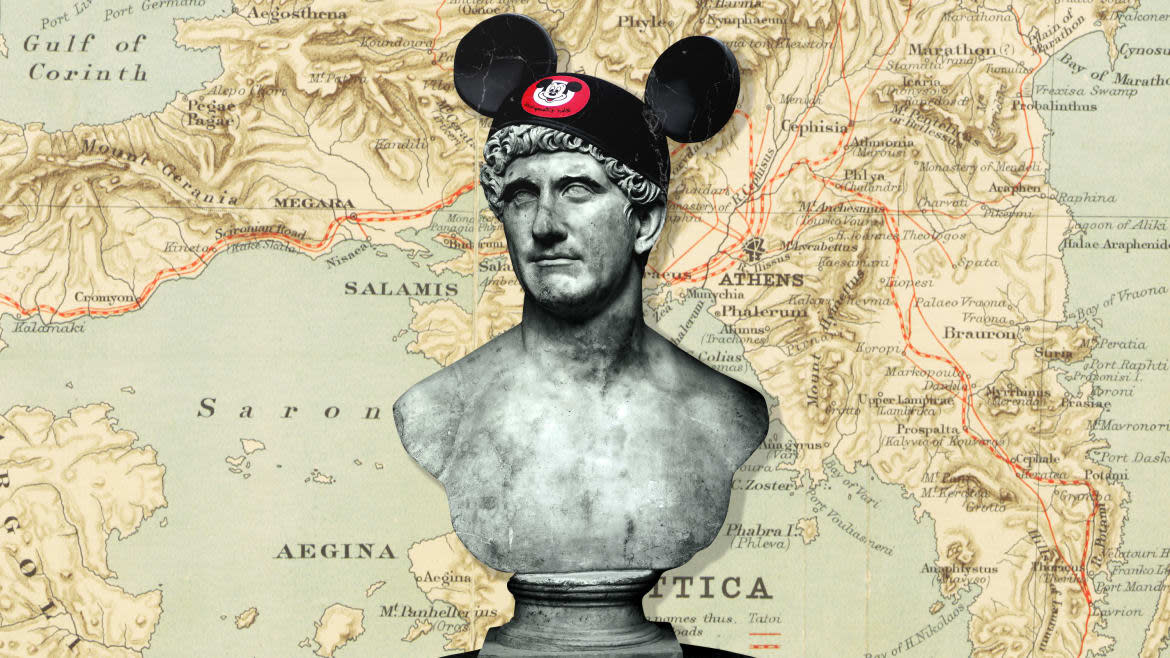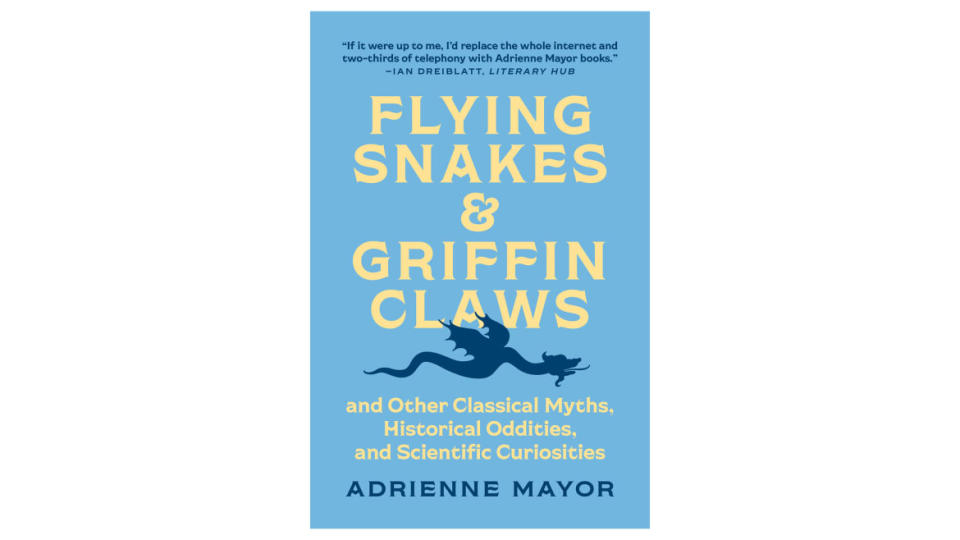Ancient Greece Was a Debauched Disney Trip for Romans

- Oops!Something went wrong.Please try again later.
Ages before modern tourists flocked to Greece to enjoy its sun, sea, antiquities, and adventure, people of the Roman Empire descended on Greece for the same reasons. Antony and Cleopatra headed for a romantic island tryst on Samos; the emperor Tiberius preferred Rhodes.
Some Romans attended the famous philosophy schools and drenched themselves in Greek history; others came for the Olympic Games; still others were attracted by the sensational—a chance to gawk at the egg hatched by Leda after her affair with Zeus in the guise of a swan, to dip a toe in the spring where Helen had bathed, or to gasp as professional divers jumped off the notorious “Lover’s Leap” of Leucadia, a 200-foot promontory where Sappho was said to have ended her life. And they all lugged home souvenirs: terracotta statuettes, trinkets, pots of Hymettian honey, silk scarves from Cos, gnarled walking sticks from Sparta, copies of racy Milesian love stories, and entire temple columns and thousands of statues.
Greek hospitality was renowned long before the Roman sightseers arrived. People who traveled often had “guest-friends” in Greek cities, and as early as the fifth century B.C. innkeepers let rooms in towns and along roads. Famous temples and sanctuaries provided public accommodations run by the host city or by other cities for their own citizens visiting the shrine. The fourth-century politician Demosthenes mentioned a hotel popular with ambassadors near the Temple of the Twins in Pherae on the northern coast of Greece, and the remains of an ancient hostel for visitors to Athens was found in Plateia in modern times.
Herodotus was one of the first ancient writers to travel purely for curiosity and pleasure in the fifth century B.C.. His books related the many strange customs and marvels he saw and heard about on his tours (see chapters 1 and 21). By the fourth century B.C., foreign travel was becoming more common, as diplomats, messengers, mercenaries, tradespeople, merchants, poets, philosophers, musicians, artists, actors, and athletes all traveled for business, education, or pleasure. Ordinary and rich folk alike made journeys to attend festivals and religious celebrations.
In the fifth century B.C. Sparta allowed visitors only short, rigidly supervised tours of its sights and restricted the travel of its own citizens. By Roman times, however, Sparta had become a sort of “theme park,” a must-see on every tourist’s list, where Old Sparta’s myths, legendary austerity, and harsh discipline were glorified. Gullible tourists could view Leda’s Egg (out of which Helen of Troy hatched; sophisticated travelers dismissed the large beribboned egg as that of an ostrich). Those familiar with the verses of the popular Roman poet Ovid probably hoped to see beautiful Spartan women wrestling in the nude, but they had to settle for statues of clothed female runners or women warriors brandishing swords. Tourists could watch endurance contests in which stoic Spartan teenagers were flogged, in the theater built by Roman entrepreneurs to accommodate hundreds of spectators. Or they could witness puppy sacrifices, exciting boar hunts, and brutal mock battles; visit the cave where criminals were confined, the altar where human sacrifices took place, and the notorious gorge where weak children were left to die. They could admire “vicious Laconian hounds” paraded on leashes; and wander through the impressive “victory” colonnade displaying Persian spoils and columns in the forms of chained captives.

Many of the bloodthirsty images of ancient Sparta current today actually come from descriptions of these commercialized sideshows created to entertain the Roman tourists.
Travelers stayed at inns along roads, near the city gates, or in the town center. Then, as now, the comforts of these lodgings varied enormously. In the cheapest, travelers had to provide their own food and linens, and they could expect to encounter hard beds, bedbugs, mosquitoes, little privacy, shady characters, and brawls. Wealthier tourists avoided these quarters and booked accommodations in luxurious converted mansions, with garden patios or dining rooms catering to Romans used to reclining during dinner. Wayfarers could buy simple snacks and wine at a modest café called a kapilos. All inns of the day provided sexual companionship of varying standards and costs.
Rich, famous, and powerful globe-trotters, such as Cleopatra and Antony, who cruised the Aegean in 40–30 B.C., traveled first class. In April of 32 B.C. the pair sailed from Ephesus to Samos, bringing with them a retinue of popular actors, comedians, and musicians. For three weeks their revels were the talk of Greece: the island resounded with the sounds of pipes and lutes; there were sumptuous drunken banquets and all-night performances. Cleopatra’s souvenirs from Samos included life-size bronze statues of Zeus, Athena, and Heracles taken from the Temple of Hera. She also took home scores of paintings and thousands of books. Antony bought Greek costumes for himself. Cleopatra was hoping to persuade Antony to get a divorce from his wife in Rome. But he was preoccupied with the upcoming showdown with Octavian (future emperor Augustus) in the Adriatic. The couple sailed from Samos to Athens, alternately bickering and making up all the way.
The tempestuous affair continued in Athens, where the city raised statues to both lovers on the Acropolis and hailed Cleopatra as the Goddess of Love and Antony as Dionysos. There were more riotous drinking bouts, torchlight parades, and outrageous behavior. Antony dressed up in a Dionysos costume. Cleopatra bought tablets of onyx and crystal, had them inscribed with love letters, and sent them to Antony. Antony caused a scandal by caressing her feet in public. The lovers moved their celebrations to the city of Patras, but by September of 30 B.C. the party was over. They both committed suicide after their fleet was defeated by Octavian at Actium in the Gulf of Preveza.
A Roman sightseer’s list of not-to-be-missed destinations reads like the itinerary of today’s traveler: Athens and its harbor Piraeus, Delphi, Corinth, Sparta, Olympia, and Epidauros. The Olympic Games and those at Nemea, Delphi, and Isthmia continued full bore, and there were Greek theatrical, literary, oratorical, and musical events galore. Local folk dances and festivals drew spectators, and energetic tourists, such as the emperor Hadrian, climbed mountains for the spectacular views. Strabo, the geographer of the first century B.C .who described the diving shows that took place at Sappho’s Leap, was very impressed with the sunset panorama visible from the great Acropolis of Corinth.
In about AD 160, Pausanias wrote A Description of Greece, the first guidebook and the model for all subsequent efforts. Pausanias’s Greek vacation lasted between 10 and 20 years. Some speculate he began his trip to forget an unhappy love affair, as had Propertius, whose grand tour to Greece was undertaken to “erase the scar in my heart.” Pausanias’s guidebook, written for philhellenic sightseers and still relied on today, is jam-packed with information on history, sights, road conditions, time-saving hints, and curiosities throughout the Greek world.
By the time Pausanias began his excursion, the Roman Empire was maintaining and policing roads (many of which are still extant) and regulating inns, mules, and carriages in Greece. Carts could be hired in one city and left in the next, like modern rental cars. The emperor Hadrian had widened the road from Athens to Corinth to accommodate two lanes of chariots, and the great Via Egnatia connected the northwest coast of Greece with Constantinople. Nero and other investors built inns along the Via Egnatia. Large public latrines were constructed near the Agora in Athens to accommodate visitors. At famous sites, cicerones offered their services and guidebooks were hawked, along with souvenirs and art reproductions. In the Agora, for example, one could buy miniature busts of Socrates near the “very spot where he drank the hemlock.” The Oracle at Delphi, once consulted by kings and emperors on foreign policy, had become a Guru to the Stars—wealthy private citizens, including Cicero and Nero, now made the journey to have their fortunes told. Other oracles and fortune-telling concessions proliferated—Pausanias described dozens of them, featuring dice, mirrors, lizards, birds, dream interpretations, and magic potions.
Pausanias sought out places of historical or romantic interest, and he was always on the lookout for antiquities. Like Herodotus, Pausanias sometimes made a nuisance of himself with his curiosity, pestering and contradicting local guides and arguing with other tourists over fine points of ancient Greek religion. He usually traveled by horse cart, going on foot when the route was narrow and “only fit for an active man.” Complaints about steep footpaths and bad roads pepper his book, but Pausanias always lets the reader know whether the sight is worth the trouble.
Local guides pointed out so many “Hercules slept here” places and “Helen bathed here” pools that Roman tourists must have pounced on Pausanias’s rating system with sighs of relief. His ratings ranged from the superlative “you’ll gasp,” “I was amazed,” “my favorite,” “very worthwhile,” and “delightful,” to downright “silly,” “stupid,” “utterly idiotic,” and “waste of time.” In his many years of touring Greece, Pausanias was shown countless Helen’s Pools and Hercules Passed Here attractions. Epidauros, for instance, boasted an olive tree “twisted by Hercules himself.” He admired myriad springs bubbling up where Pegasus Stamped His Hoof (there was one in Corinth), places where Medusa Was Slain (Argos had one of these), springs where Hera Renewed Her Virginity (one near Eleusis and another at Nauplion), shady glades where Dionysos Stopped for a Drink or Zeus Met a Maiden (ubiquitous), grottoes where Pluto Abducted Persephone to the Underworld (at Nauplion, Troezen, Hermione, Boeotia, etc.), caves of Various Lions Wrestled by Hercules (Tiryns, Nemea, Mount Kitheron), and dozens of rival birthplaces and graves of heroes and gods.
On the Corinthian Gulf near Patras, Pausanias found “a delightful place for idling in the summer.” He noticed that Patras itself had twice as many women as men, and “if ever women belonged to Aphrodite, they do!” These women were expert weavers of cotton and flax, and their decorative hairnets and dresses were popular souvenirs of Patras. Pausanias consulted no fewer than three fortune-telling oracles near here, and he was enchanted by the story of a man who fell hopelessly in love with a faithless mermaid in the Selinous River. Bathing in the river, the guides assured Pausanias, could make one forget an unhappy passion. “If true, the river water is worth more to mankind than any amount of money,” he remarked. His discovery of the delights of the coast near Patras, like Tiberius’s fondness for voltas (evening strolls) with villagers in Rhodes, and Strabo’s ascent of Acrocorinth for the thrilling view, remind us that, besides the glorious antiquities and stirring history, it is this glimpse of the real and present Greece, the unique out-of-the-way experience, that every visitor hopes to treasure as a personal souvenir.
By the third century A.D., worsening economic and social conditions, not to mention barbarian hordes, made gadding about the Mediterranean for the pure fun of it simply too adventurous for most people. After three centuries of relatively safe travel guaranteed by the “Roman peace,” more than a thousand years would pass before philhellenes would again make Grand Tours to Greece to satisfy curiosity and to seek history and adventure.
Excerpted from FLYING SNAKES AND GRIFFIN CLAWS: And Other Classical Myths, Historical Oddities, and Scientific Curiosities by Adrienne Mayor. Copyright © 2022 by Princeton University Press. Reprinted by permission.
Get the Daily Beast's biggest scoops and scandals delivered right to your inbox. Sign up now.
Stay informed and gain unlimited access to the Daily Beast's unmatched reporting. Subscribe now.

